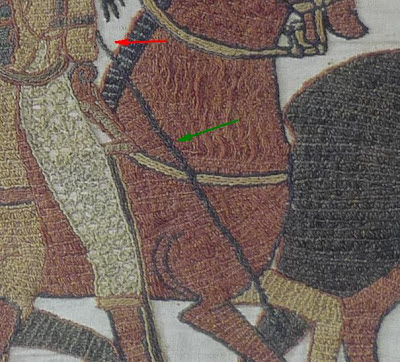Lorsque j'ai été apprendre le point de Bayeux en normandie, l'animatrice m'avait dit qu'on n'utilisait que du point de tige et du point de Bayeux. Mais j'ai lu récemment sur le site officiel, qu'on pouvait aussi trouver du point de chaînette et du point fendu. Du coup, ça m'a donné à réfléchir. Je pense que j'ai déjà rencontré un de ces deux points, au niveau de cette étrivière (flèche verte).
When I was learning the Bayeux stitch in Normandy, the teacher told me they only used stem stitchs and Bayeux stitchs. But I recently read on the official website, that you could also find chain stitchs and split stitchs. So, I think I've ever met one of these two points, at this stirrup (green arrow).
Mais pensant que ça ne pouvait être que du point de tige, j'en avais utilisé deux rangées côte-à-côte (flèche verte), en veillant à ce que les points soient au même niveau. Le rendu obtenu est assez proche.
But thinking it could be stem stitch, I had used two rows of this, side by side (green arrow), ensuring that the points are at the same level. The rendering I obtained is quite close.
Evidemment, à la lumière de ce renseignement récent, il me parait évident qu'il s'agissait en fait d'un point de chaînette ou d'un point fendu. Aujourd'hui, Je me retrouve de nouveau face à ce point, pour la hampe de la lance.
Obviously, in light of this recent information, it seems obvious to me that this was actually a chain stitch or split stitch. Today, I have to deal once again with this sort of stitch, for the shaft of the spear.
En regardant de près la photo, on voit bien qu'on a ici un de ces deux points.
Mais deux questions se pose :
- point de chaînette ou point fendu ? Je pencherais plutôt pour le second, mais je suis intéressée par vos avis de brodeuses expérimentées.
- en regardant d'encore plus près (si si, penchez-vous un peu, vous verrez), il semble que la brodeuse ai voulu rendre le fait que la lance s'effile vers la pointe, et qu'au début, on ai un point fendu (flèche verte) mais que vers le bout, elle soit passée à un point de tige (flèche rouge). A moins que ce ne soit un point de chaînette en bas, et un point fendu en haut. A bien y réfléchir, ça pourrait bien être cette dernière possibilité. Pensez-vous que mon interprétation soit juste, et dans ce cas, OU se fait le changement ?
Looking at the photo, it is clear we have here one of these two stitchs.
But two questions arise:
- Chain stitch or split stitch ? I incline rather to the second, but I'm interested in your opinion of experienced embroiderers.
- Looking even more closely, it seems that the embroiderer wanted to make the spear thiner toward the tip. Then at the beginning, she made split stitch (green arrow) but at the end, she passed to a stem stitch (red arrow). Or perhaps it is a chain stitch at the bottom, and a split stitch up. On second thought, it could well be the latter possibility. Do you think my interpretation is correct, and in this case, WHERE is the change?



I admire your project, Isabelle! I enjoy seeing what you do! Hard to decide where a change of stitch takes pplace if there is one at all. Maybe at the contour of the horse's neck. I would stitch in both stithes and the compare what is most similar. But, sorry, I have no experience ! I'm very interested what will happen!
RépondreSupprimerHappy Stitching! Claudia
Moi je dirais même que le bas de la flèche est à nouveau en point de tige.( une fois que l'on n'est plus sur le cheval.).. mais point de chainette ou tige fendu, alors là, si les points sont courts, cela ce ressemble beaucoup . Bon, je repars avec le mien ,en mettant bien sur un lien vers chez toi, ( origine de la contagion)lol
RépondreSupprimerPour le bas de la lance, je ne sais pas, crazy,j'ai l'impression que la largeur est la même. mais c'est difficile à dire parce que la broderie est assez abîmée à cet endroit.
RépondreSupprimerbonjour,
RépondreSupprimervous pouvez aller sur mon site pour avoir d'autres renseignements www.bayeux-broderie.com